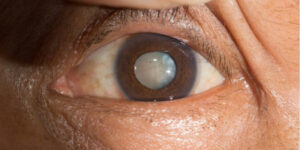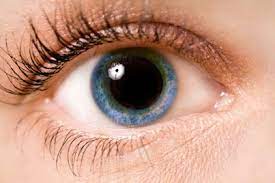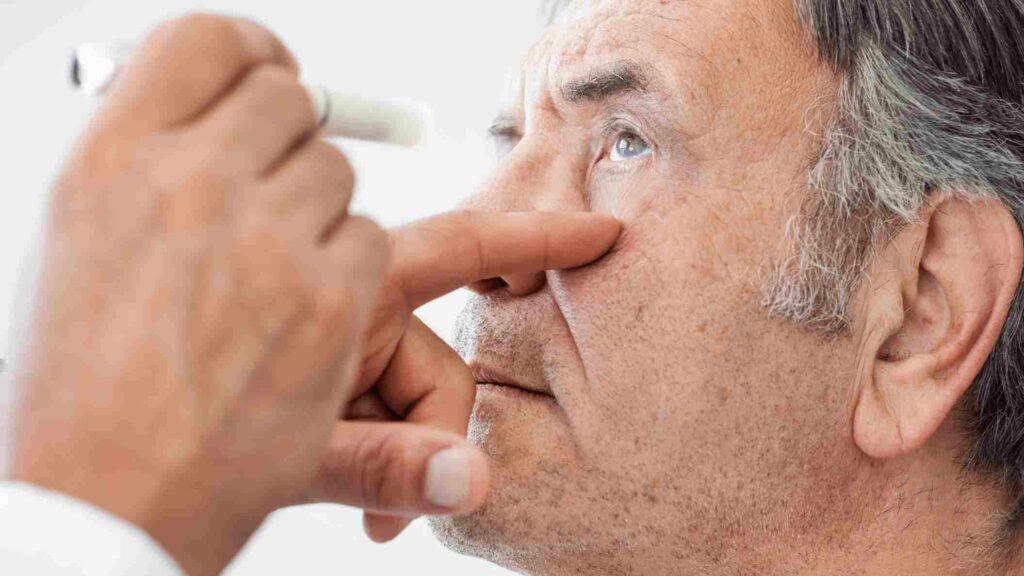Do you have trouble seeing at night? Do your eyes feel tired after a long day of work? You may be suffering from a cataract. A cataract is a clouding of the lens in the eye, which can lead to blurry vision and other problems. In this blog post, we will discuss how to determine if you have a cataract and discuss the cataract test used to determine it. We will also talk about treatment options and ways to prevent cataracts from developing.
What Is A Cataract?
 A cataract is a clouding of the eye’s natural lens. Most cataracts develop slowly and don’t disturb vision early on. This is described as a “mild” cataract.
A cataract is a clouding of the eye’s natural lens. Most cataracts develop slowly and don’t disturb vision early on. This is described as a “mild” cataract.
As a cataract matures, it may cause more vision problems. A mature cataract can make light from the sun or lamps seem too bright. It can also cause colors to appear faded and makes it difficult to see at night. In fact, it can cause complete blindness if not treated. There are three main types of cataracts:
- Age-related cataracts. This is the most common type, usually affecting people over age 60.
- Congenital cataracts. These occur in babies and young children and may be present at birth.
- Secondary cataracts. These occur as a result of another eye condition, an injury, or long-term medical problems such as diabetes.
These are just a few facts about cataracts. If you think you or someone you know may have a cataract, please consult an eye doctor for more information and to get the proper diagnosis.
What Are The Types Of Cataract Tests?
A cataract test is important for diagnosing and managing the condition. There are three main types of tests: visual acuity test, slit lamp examination, and dilated eye exam. Let’s discuss each one in more detail.
Visual acuity test
The visual acuity test is the most commonly used test to diagnose cataracts. This test measures how well you can see at different distances. To do this, your doctor will ask you to read from an eye chart. If you have a cataract, you will likely have difficulty reading the smaller letters on the chart. This is because cataracts can cause your vision to become blurry or cloudy.
Slit lamp examination
A slit lamp examination is a type of eye exam that uses a special microscope to closely examine the structures of your eye. During this test, your doctor will look for signs of cataracts, such as cloudy areas in the lens of your eye. Moreover, slit lamp examination is also used to assess the severity of cataracts. For example, if the cataract is causing significant vision loss, your doctor may recommend surgery.
Dilated eye exam
 A dilated eye exam is another type of test that can be used to diagnose cataracts. During this test, your doctor will place drops in your eyes to widen (dilate) your pupils. This allows them to get a better view of the structures in your eye, including the lens. If you have a cataract, you will likely have cloudy areas in the lens of your eye.
A dilated eye exam is another type of test that can be used to diagnose cataracts. During this test, your doctor will place drops in your eyes to widen (dilate) your pupils. This allows them to get a better view of the structures in your eye, including the lens. If you have a cataract, you will likely have cloudy areas in the lens of your eye.
So the cataract test is important to get done in order to see what the next step will be. Make sure you go and get them done as soon as possible so that way you can start taking care of your eyesight. These are just a few of the tests that are available for cataracts, so if you think you may have a cataract, be sure to ask your doctor about what tests are right for you.
Can Cataract Test Be Done At Home?
This is a common question we get asked, and unfortunately, the answer is no. Cataract testing requires specialized equipment that is not available for home use. The good news is that a cataract test is quick, painless, and usually covered by insurance.
However, there are some at-home methods for checking if you have a cataract. One is the flashlight test. Stand in a dark room and shine a flashlight directly into your eye. If you see a halo around the light, it could be an early sign of a cataract. Another method is to look at pictures you took previously.
Also, take note if you’ve been experiencing any changes in your vision. If you’ve been having trouble seeing at night or have noticed that your colors seem duller than usual, these could be signs of a cataract.
If you are over the age of 40 and notice that your vision has become blurry or cloudy, you may be developing a cataract. The best way to determine if you have a cataract is to schedule an appointment with your eye doctor. A cataract test is really an important test to take especially when you reach a certain age because cataracts usually form slowly and painlessly.
It is important to catch cataracts early so they can be treated before they cause serious vision problems. So, do not wait to get your eyes checked! Early detection and treatment are important in order to prevent serious vision problems.
How To Treat It?
 When the tests come back positive for a cataract, the next step is to talk to your doctor about treatment options. In most cases, surgery is the best way to treat a cataract. The surgery is usually quick and painless, and it can usually be done on an outpatient basis. After the surgery, you should be able to see much better.
When the tests come back positive for a cataract, the next step is to talk to your doctor about treatment options. In most cases, surgery is the best way to treat a cataract. The surgery is usually quick and painless, and it can usually be done on an outpatient basis. After the surgery, you should be able to see much better.
Cataract surgery is usually done by an ophthalmologist, a doctor who specializes in eye care. The surgery usually takes less than an hour, and you will be able to go home the same day. During the surgery, the ophthalmologist will make a small incision in your eye and remove the cataract.
In most cases, the surgeon will also put an artificial lens in your eye. This lens will help you focus better. You may need to wear glasses or contact lenses after the surgery, but in most cases, people who have cataract surgery have much better vision than they did before the surgery.
There are also various types of surgery that can be done to treat a cataract. Your doctor will discuss the best for you based on your individual situation. So, do not hesitate to ask lots of questions and get all the information you can before making a decision.
What Are Some Ways To Prevent It?
This is a difficult question to answer because cataracts can develop for a number of reasons. As Age-related cataracts are the most common type of cataract, and unfortunately, there is no real way to prevent them. However, there are a few tips that can help you prevent other types of cataracts, or at least slow down the progression.
Wear sunglasses
Ultraviolet (UV) light accelerates the formation of cataracts. Wearing good-quality sunglasses that block both UVA and UVB rays can help protect your eyes from harmful sun exposure. This is an especially important precaution if you spend a lot of time outdoors or if you have light-colored eyes, which offer less natural protection against UV rays.
Stop smoking
Smoking is a risk factor for many eye diseases, including cataracts. If you smoke, quitting is the best way to protect your vision. Because when you smoke, harmful chemicals from tobacco enter your bloodstream and are then carried to all parts of your body, including your eyes. It is one of the most preventable risk factors for developing cataracts.
Eat healthy foods
Eating a healthy diet helps reduce your risk of developing cataracts and other conditions such as macular degeneration. Foods rich in antioxidants — such as leafy green vegetables, oranges, tomatoes, and blueberries — may help protect your eyes from damaging free radicals. Omega-three fatty acids found in fish, such as salmon and tuna, also have been linked with a reduced risk of cataracts.
Limit alcohol consumption
 Alcohol is considered a toxin to the human body. It can cause damage to your liver, brain, and other organs. When it comes to your eyes, alcohol consumption can lead to nutritional deficiencies that may increase your risk of cataracts. For example, if you don’t eat enough foods that contain vitamin A, you may be more likely to develop night blindness, which is an early symptom of cataracts. So it’s best to limit your alcohol intake to no more than one drink per day.
Alcohol is considered a toxin to the human body. It can cause damage to your liver, brain, and other organs. When it comes to your eyes, alcohol consumption can lead to nutritional deficiencies that may increase your risk of cataracts. For example, if you don’t eat enough foods that contain vitamin A, you may be more likely to develop night blindness, which is an early symptom of cataracts. So it’s best to limit your alcohol intake to no more than one drink per day.
Get regular checkups
Cataract never develops immediately or overnight. It is a gradual process that can take years to develop. That’s why it’s important to get regular checkups, so your doctor can keep an eye on any changes in your vision. Because when you finally do develop a cataract, you want to be sure to catch it early.
So these are some of the ways you can prevent cataracts, or at least slow down the development of cataracts. There are also certain risk factors that can make you more likely to develop cataracts. Therefore, you must adhere to the following tips to keep your eyes healthy and free from cataracts.
Conclusion
To conclude, a cataract test is important for catching this eye condition early. When caught early, cataracts can be treated with surgery to improve your vision. If you think you might have a cataract, schedule an appointment with your doctor or ophthalmologist today. They will be able to give you a thorough examination and better determine if you have a cataract.
Also, as discussed cataract test at home is also possible, you just need a few common household items. If you notice any changes in your vision, be sure to schedule an appointment with your doctor. Catching a cataract early is key to maintaining good vision.
You can also contact EyeMantra for more information and resources. At EyeMantra we have a team of experienced eye surgeons, who will be happy to answer your questions on cataract surgery, cataract surgery cost, and cataract lens cost for different cataract surgery types- Phacoemulsification, MICS & Femto Laser Cataract. Call us at +91-9711116605 or email at [email protected] for inquiries.


